Cite this document
(Epidemiological Significance of Cholera Term Paper, n.d.)
Epidemiological Significance of Cholera Term Paper. https://studentshare.org/medical-science/1795564-epidemiological-significance-of-cholera
Epidemiological Significance of Cholera Term Paper. https://studentshare.org/medical-science/1795564-epidemiological-significance-of-cholera
(Epidemiological Significance of Cholera Term Paper)
Epidemiological Significance of Cholera Term Paper. https://studentshare.org/medical-science/1795564-epidemiological-significance-of-cholera.
Epidemiological Significance of Cholera Term Paper. https://studentshare.org/medical-science/1795564-epidemiological-significance-of-cholera.
“Epidemiological Significance of Cholera Term Paper”. https://studentshare.org/medical-science/1795564-epidemiological-significance-of-cholera.


